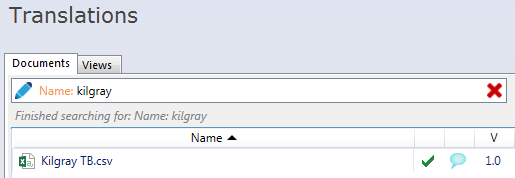|
Search the Translations pane. Enter a word or an expression in the search field. Then click the Search icon ( How to begin Click the Edit icon (
When you start searching the Translations pane, the items found by the search are displayed in the flat list view, i.e. without structure.
When you enter a search phrase, and press Enter, or click the search icon, the displayed view will clear and a message e.g. “Searching for <search phrase>” will appear in grey italic letters below the search box. memoQ then populates the display with items as they are found, and changes the message to “Finished searching for <search phrase>” once the search has fully finished. You then see a filtered view in the Translations pane. When you enter a search criterion in the search field, memoQ remembers the filtering set up in the grid. For example when you click the Edit icon to access the project filtering, select "Name" for field name, choose a project name and apply the filter. Click the Edit icon again. memoQ remembers the entered criteria. You can modify the criteria. UseThe search box allows you to filter of what is listed in the Translations pane. •Type in an arbitrary search string to search for its appearance in all fields. So for example type "word", and memoQ will find all Word documents, all documents that were imported by the Microsoft Word filter, all documents (regardless of their type) that contain "word" in their name (e.g. wordlist.txt), all folders that contain "word" in their name. memoQ also finds all documents assigned to people whose name contains "Word", e.g. if the translator’s name is "Wordsworth". Note: "type:document" excludes all images, but includes other types of embedded documents. •Narrow down your search by using keywords. For example, "type:folder" will list all folders. "word type:folder" will list all folders that contain "word" in their name. "word type:document" will list all documents that are either Word files or contain "word" in their name. To exclude Word documents from the list, the search phrase is "name:word type:document". To list all Word files regardless of name, use "type:word" or "type:docx". "Translator:word" will find only documents whose translator’s name contains "word". •Use keywords: title (of a document); type (this will include the list of all file extensions that are supported); assigned (followed by a user name, should look for all four possible roles), translator (followed by user name), just like r1/reviewer1, r2/reviewer2, project manager; created (a date or user name). •createdby (enter a user name); deadline (enter a date, or keywords like yesterday, today, tomorrow, last/next week/month); size (followed by a number which is understood by default as words, and an optional qualifier, which can be: segment/segments, word(s), character(s); sliced (followed by yes/no); unassigned; progress (< or > and a number, which is interpreted as a percentage); delivered (yes/no); translated (yes/no); proofread (yes/no). •Search for dates: enter ranges like "before", "after", "within", and keywords like "today", "tomorrow", "yesterday", "week", "month", "year". NavigationClick OK to apply the filter criteria. Click Cancel to cancel the Edit filter dialog and to return to the unfiltered Translations pane. Then click the Search icon (
|

